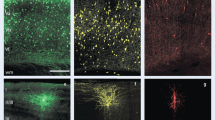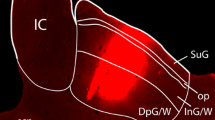Abstract
Antisera to GABA and histamine (HA) label distinct populations of interneurons that innervate glomeruli in the olfactory lobe (OL) of the spiny lobster. GABA-immunoreactive interneurons branch most heavily in the cap of the glomeruli, while HA-immunoreactive interneurons branch mostly in the glomerular subcap. Perfusing GABA or HA into the isolated brain increases the intensity of electrical stimulation of the antennular nerve necessary to elicit action potentials in OL projection neurons. The GABA receptor antagonist picrotoxin (30–100 μmol · l−1) and the HA receptor antagonist cimetidine (1–5 mmol · l−1) both reduce the stimulus intensity needed to elicit action potentials. However, cimetidine also eliminates the hyperpolarizing phase of the evoked response and reveals a delayed, prolonged excitation of up to 10 s, whereas picrotoxin enhances the hyperpolarization and, at higher concentrations, transiently suppresses all phases of the evoked response. We conclude that GABA- and HA-ergic interneurons constitute two overlapping, yet functionally distinct inhibitory pathways in the OL, an organizational feature which may be fundamental to processing at this level of the olfactory pathway.
Similar content being viewed by others
Author information
Authors and Affiliations
Additional information
Accepted: 28 October 1996
Rights and permissions
About this article
Cite this article
Wachowiak, M., Ache, B. Dual inhibitory pathways mediated by GABA- and histaminergic interneurons in the lobster olfactory lobe. J Comp Physiol A 180, 357–372 (1997). https://doi.org/10.1007/s003590050055
Issue Date:
DOI: https://doi.org/10.1007/s003590050055




